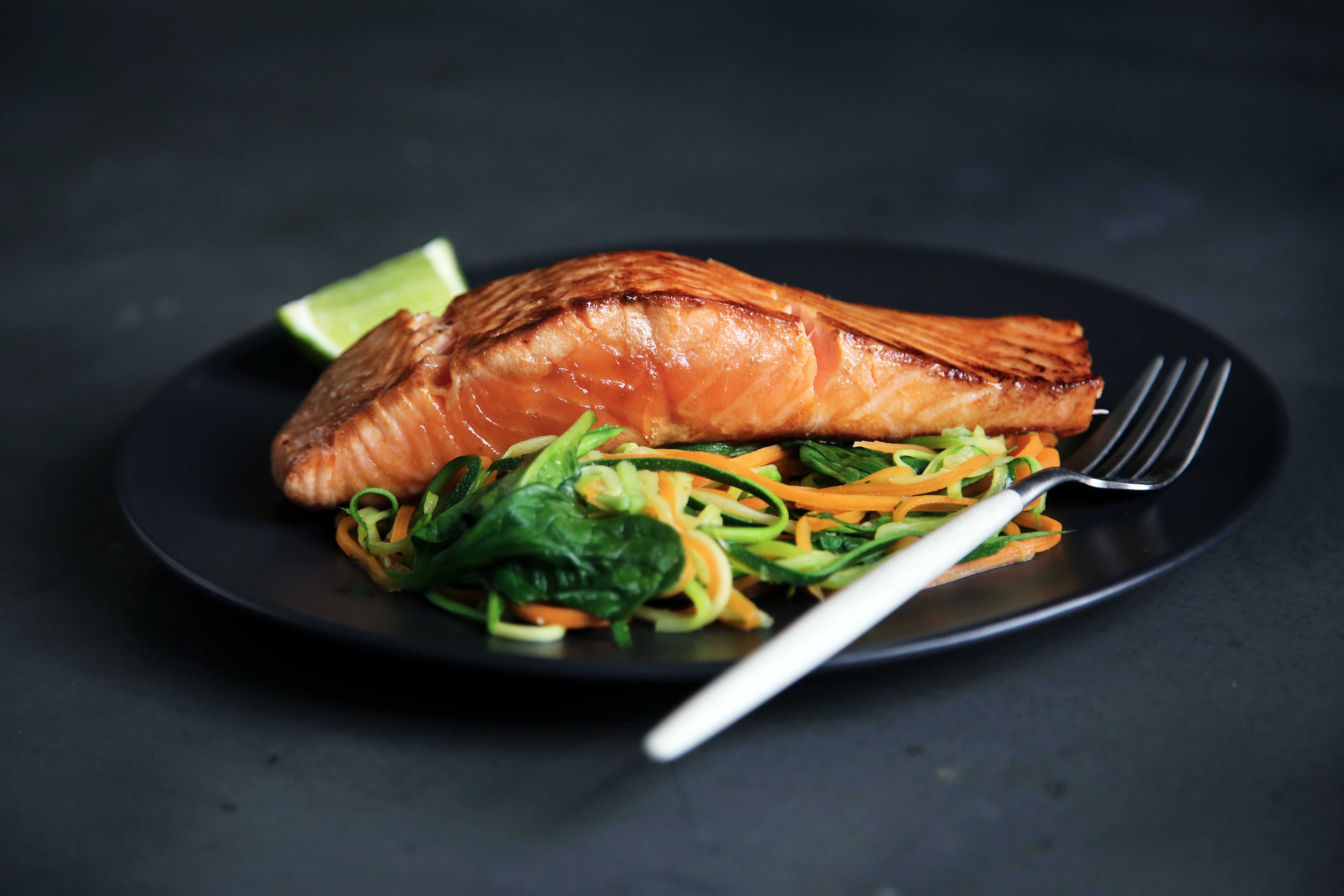Why you should be enjoying sun and salmon right now!
 Having lived in New England for a few years, when I think of fall, I think of this visual. However, living in Oakland, California, fall means sun and salmon season. It is definitely the best time of year and the farmer’s market has delicious salmon right now. So, what is my point?
Having lived in New England for a few years, when I think of fall, I think of this visual. However, living in Oakland, California, fall means sun and salmon season. It is definitely the best time of year and the farmer’s market has delicious salmon right now. So, what is my point?
Well, I was trying to figure out what to write about this month, taking in to account that we are basically in the same situation since March; which means that immunity should still be top of mind. And yet, I wanted a different topic, one that was relevant but not tied directly to COVID-19. Long story, longer this (for me) led to nutrients for health.
Vitamin D is once again back in the news and what better sources than the sun and some salmon.
The reason I am bringing vitamin D up is (1) many people are deficient in vitamin D and (2) with each week there is mounting evidence that having sufficient levels of D may prove beneficial in fighting the Covid-19 infection. Some studies are showing that people with lower levels of vitamin D are more likely to test positive for the coronavirus, have more severe infections and increased need for ICU. Mind you, vitamin D has not been shown to prevent or treat the coronavirus.
Every cell in your body has a vitamin D receptor. Every cell!
Every cell has a specific task and therefore a specific need for nutrients, this means we have a substantial need for vitamin D. Here are just some of the functions it is involved in:
Wow! That is one busy vitamin/hormone. And because it is involved in so many functions it is crucial that we keep an ever-present supply available.
What you need to know about Vitamin D
1.There are two main forms of vitamin D:
- Vitamin D3, which is formed in the skin after exposure to sunlight and from consumption of animal-sourced foods.
- Vitamin D2, which is obtained mainly through plant sources and fortified foods.
Fun fact: vitamin D in its active form it is a hormone! Despite the original misnaming of vitamin D this term has continued to be used.
2.There are three ways to obtain vitamin D: Sun, Food and Supplements.
Sun –
Your body makes vitamin D when direct sunlight converts a chemical in your skin into an active form of the vitamin. There are some limiting factors, however, such as location, time of year, skin pigmentation, age, pollution, and application of sunscreen. Due to these varying factors, it’s challenging to state a general amount of time one must spend outside.
A very loose rule of thumb is 15 minutes to face, arms, and hands at least twice a week without sunscreen. Safe-sun exposure is before 10am and after 2 pm. 
Or, check out this great, free app, to learn how much time to spend in the sun depending on your age, skin color, and location: D minder!
Food –
The next best source of vitamin D is obtained from whole foods. In comparison to other nutrients, the list of vitamin D containing foods is quite short.
According to The World’s Healthiest Foods:
- Wild-caught salmon is the best food source of vitamin D as a single serving contains more than the generally suggested Daily Value (DV).
- Sardines contain over 40% of the DV and tuna contains just under 25%.
- Pasture-raised eggs are a good source of dietary vitamin D, with about 10% of the DV per egg. The vitamin D is concentrated in the yolk, so you’ll need to eat the whole egg to get it.
- Some mushroom species, including shiitakes, contain as much as 5% of the DV.
Vitamin D is a fat-soluble vitamin which means it needs fat to be properly absorbed into your system.
Supplements –
Vitamin D3 is the preferred form as it has been shown to raise levels more effectively and give more accurate test results. Calcifediol an analogue of D3 is the most efficient at raising 25-Hydroxyvitamin D status. While vitamin D is stored in the body (unlike water soluble B vitamins), it may take weeks or months to raise levels sufficiently.
Take vitamin D with your biggest meal that contains fats or oils for best absorption. If you find that sleep disruptions occur, take it with breakfast or as early in the day as possible.
More is NOT better. I believe you have all heard this by now. No mega doses and take only what you need to raise your levels. Work with a qualified professional.
3.What is a sufficient vitamin D level?
Everyone should be tested just to be safe. As with many things there is a debate among experts on what is sufficient. The test results will be given as total 25-Hydroxyvitamin D status (the pre-hormone form of vitamin D) in blood. This is the storage form of vitamin D, which is converted by the kidneys to the biologically active form, 1,25dihydroxycholecalciferol.
- A total serum 25-hydroxyvitamin D level of 20 ng/mL is considered “sufficient” by many doctors but it is not enough for vibrant health.
- The Vitamin D Council places the ideal level between 40 and 80 ng/mL with levels below 20 ng/mL as deficient.
- The Endocrine Society guidelines recommend a minimum vitamin D level of 20 ng/mL, but to guarantee sufficiency they recommend between 30 and 50 ng/mL.
So, to be safe, talk to your doctor and see if they agree that you should stay within 40 and 80 ng/mL.
Remember, vitamin D is used by every single cell so keeping within a safe but higher recommended range might prove the best course of action for maintaining vibrant health and strong immunity.
Until next month, stay well and enjoy some salmon and sun!
Photos by Jakob Owens, Sunday Coulter and Caroline Attwood on Unsplash https://www.consumerlab.com/reviews/vitamin-d-supplements-review/vitamin-d/?anchor=maghbooli&j=1682136&sfmc_sub=17842635&l=529_HTML&u=21263003&mid=7276525&jb=65&utm_medium=email&utm_source=exacttarget&utm_campaign=newsletter&utm_term=&utm_content=cranberry_member_de_send#maghbooli https://endocrinenews.endocrine.org/nov-2014-just-right-how-much-vitamin-d-is-enough/ https://pubmed.ncbi.nlm.nih.gov/23829164/ Kresser, Chris. “Vitamin D: More Is Not Always Better.” Chris Kresser, 4 Sept. 2019, chriskresser.com/vitamin-d-more-is-not better/. Lips, P. “Vitamin D Physiology.” Progress in Biophysics and Molecular Biology, Pergamon, 28 Feb. 2006, www.sciencedirect.com/science/article/pii/S0079610706000083?via=ihub. Morris, Howard A. “Vitamin D: a Hormone for All Seasons--How Much Is Enough?” The Clinical Biochemist. Reviews, U.S. National Library of Medicine, Feb. 2005, www.ncbi.nlm.nih.gov/pmc/articles/PMC1240026/. “Vitamin D”, Mayo Clinic. “Vitamin D.” The World's Healthiest Foods, whfoods.com/genpage.php?tname=nutrient&dbid=110. Institute of Medicine (US) Committee on Use of Dietary Reference Intakes in Nutrition Labeling. “Overview of Food Fortification in the United States and Canada.” Dietary Reference Intakes: Guiding Principles for Nutrition Labeling and Fortification., U.S. National Library of Medicine, 1 Jan. 1970, www.ncbi.nlm.nih.gov/books/NBK208880/.




